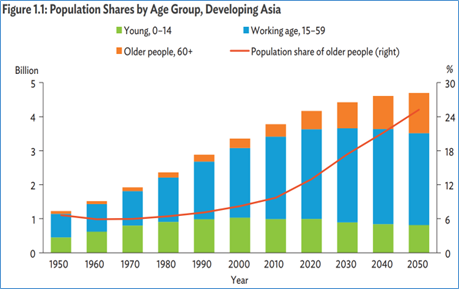PREVIOUS
Aging Well in Asia report 2024
May 7 , 2024
351 days
1270
0
- The new report titled 'Aging Well in Asia' was prepared by Asian Development Bank.
- The South Korea and Thailand have achieved universal health coverage.
- In Bangladesh, Indonesia and India, more than half of those without access to healthcare are in the bottom two wealth quintiles.
- The number of people aged 60 and older in developing Asia and the Pacific is set to nearly double by 2050 to 1.2 billion or about a quarter of the total population.
- Others lag behind with India having the lowest health insurance coverage among older people at 21%.
- At the same time, these economies have an opportunity to reap a "silver dividend" in the form of additional productivity from older people.
- It could boost gross domestic product in the region by 0.9% on average.
- Schemes like Ayushman Bharat that provides cashless healthcare to bottom quartile of population has improved health coverage since its launch.
- Expanding it further will improve the condition and make people aged over 60 years more productive for the economy.
- The share of financially prepared near-old people (those within 5 years or so of retirement) to be as high as 86% in Japan and 73% in India.
- But this is somewhat lower at 64% in China and 58% in the Republic of Korea.
- Older women in India will see the greatest increase in life expectancy at 6.4 years, followed by Kazakhstan; Georgia; and Hong Kong, China at 4.6 years.
- For older men, Armenia will have the highest increase in life expectancy at 6.1 years, followed by India at 5.7 years and Georgia at 5.2 years.

Leave a Reply
Your Comment is awaiting moderation.


